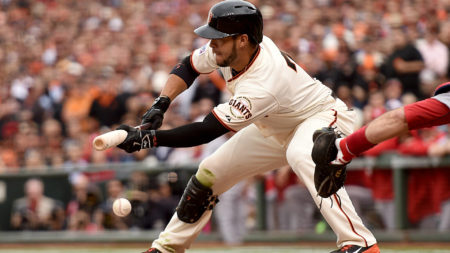Death of the Bunt: A Story of Numbers and Money
 The other night, I watched Amed Rosario of the New York Mets embarrass himself. He was trying to bunt. Over the years, I’ve seen masters bunt. Winning players like Rod Carew and Pete Rose immediately come to mind. Payers who handled the bat like an artist painting a portrait.
The other night, I watched Amed Rosario of the New York Mets embarrass himself. He was trying to bunt. Over the years, I’ve seen masters bunt. Winning players like Rod Carew and Pete Rose immediately come to mind. Payers who handled the bat like an artist painting a portrait.
In contrast, Rosario looked like a butcher who’d never seen a meat cleaver before. Of course, he failed. His bunt attempt was a definition not just of futility, but utter futility.
In fairness, Rosario, a slight shortstop, is not the first or only hitter who has humiliated himself at the plate bunting, even this year. Why Rosario, a player who’s not a home run hitter and clearly could help his team by bunting the ball, cannot bunt is a mystery.
Or is it?
Presumably, the New York Mets have hitting instructors in the minor leagues who teach bunting. Don’t they?
Then this same week a rookie recently promoted by the New York Mets, second baseman Jeff McNeil, laid down a beautiful bunt that was slightly too close to the pitcher and he was thrown out at first. But his form, the way he delicately jabbed the bat at the ball, was indicative of a player who had mastered the art of bunting. So, why could McNeil bunt and not Rosario?
Ball in Play Not a Priority
The broader question is why so many plays dedicated to putting the ball in play have gradually disappeared? The hit and run. The stolen base. The bunt. Why has baseball allowed “numbers” to strip action out of the game?
If baseball reflects the social world, what does it reflect now?
An expensive lottery ticket? Baseball played as if team managers hope cash in on every “launch angle”? Go for broke rather than build runs to win games? Are these the tickets that drive the game? The same way many in society pin their hopes on the lottery each week to win big and change their lives?
It was certainly clear during the home-run craze of the 1990s that players launching balls into orbit were paid inflated salaries, while those .300 singles and doubles hitters never seemed to reach the same pinnacle. Of course, there were exceptions like Derek Jeter. But this mania made steroid cheating into an art form deliberately ignored by management, until it became so egregious that its discovery tarnished the integrity of the game itself and may have contributed to baseball’s lack of action and home-run craziness, today.
It’s only in the last few years that one-dimensional, home-run hitters found it difficult to find new contracts. Perhaps the worst offender, Chris Carter—who led the National League with 41 home runs in 2016—has been cut by several teams the last few years because he’s so feast or famine: home run, strikeout, walk or zilch.
The fact Carter is a black man might have made him a more visible target, more so than another all-or-nothing Chris, Chris Davis of the Baltimore Orioles.
This Chris has the most onerous contract in baseball. He is signed through 2023 at $17 or so million a year. A player who led the major leagues with more than 200 strikeouts in 2015/16 and is now hitting around .150 (last I looked) and had only 14 or 15 homers this season (after his great year in 2013 when he smacked 53 home runs, which was the basis for his bloated contract). In short, Chris Davis is one of the reasons the Baltimore Orioles are as bad as they are, and he will affect their economics until his contract expires.
MLB’s New and Less Exciting Economic Era
This is the new economic reality in baseball. Avoid your own embarrassing Chris Davis fiasco.
Spend wisely. Bring in younger players who cost less and come with an energy and spirit that older players may have once oozed, but no longer exude. Younger, premium players in their six-year team control window whose salaries are controlled year by year, depending on where they are in the arbitration process, are golden now.
So, players like Aaron Judge and Luis Severino, who have yet to hit arbitration, cost the Yankees relatively little, whereas Giancarlo Stanton, whose numbers are similar to Judge’s, costs the Yankees close to $30 million a year. Yankees’ choice.
Manny Machado and Bryce Harper are also the new economics of baseball. Fabulously-skilled young players in their prime who will be free agents in 2019 and are already salivating at the unfathomable rewards ahead. Given the young ages at which many players now begin their careers, more and more players will be the next Machado or Harper—players anticipating huge paydays at 25 or 26 years old.
Which is why the trend is to sign players to team-friendly, long-term contracts as early in their career as possible, cashing in on their prime performance seasons. See Mike Trout or George Springer.
So, Mike Trout is not asked to bunt. But why don’t players who should bunt know how to bunt? Perhaps because it’s not a winning statistic. And if teams don’t value it, does that mean that they don’t teach it?
USA Today has reported, “There were only 1,025 sacrifices in the majors [in 2016], down from 1,667 in 2011. The average of 0.21 sacrifices per game in 2016 was the lowest in baseball history, according to Baseball Reference.”
The article also suggests that sabermetric evaluations of the way runs are scored in MLB clearly shows that percentages now favor scoring a runner from first base with none out over scoring a runner from second base with one out.
So, bunting is not an important constituent unit used in salary negotiations to enhance value. Worse, it could be used to diminish value, with teams claiming a player who bunts too often is a losing player.
Teams might even fail to offer contracts to players whose metrics show declining or inferior production on the field. Like those who bunt?
So, could this be a reason players are loathe to bunt anymore?

























